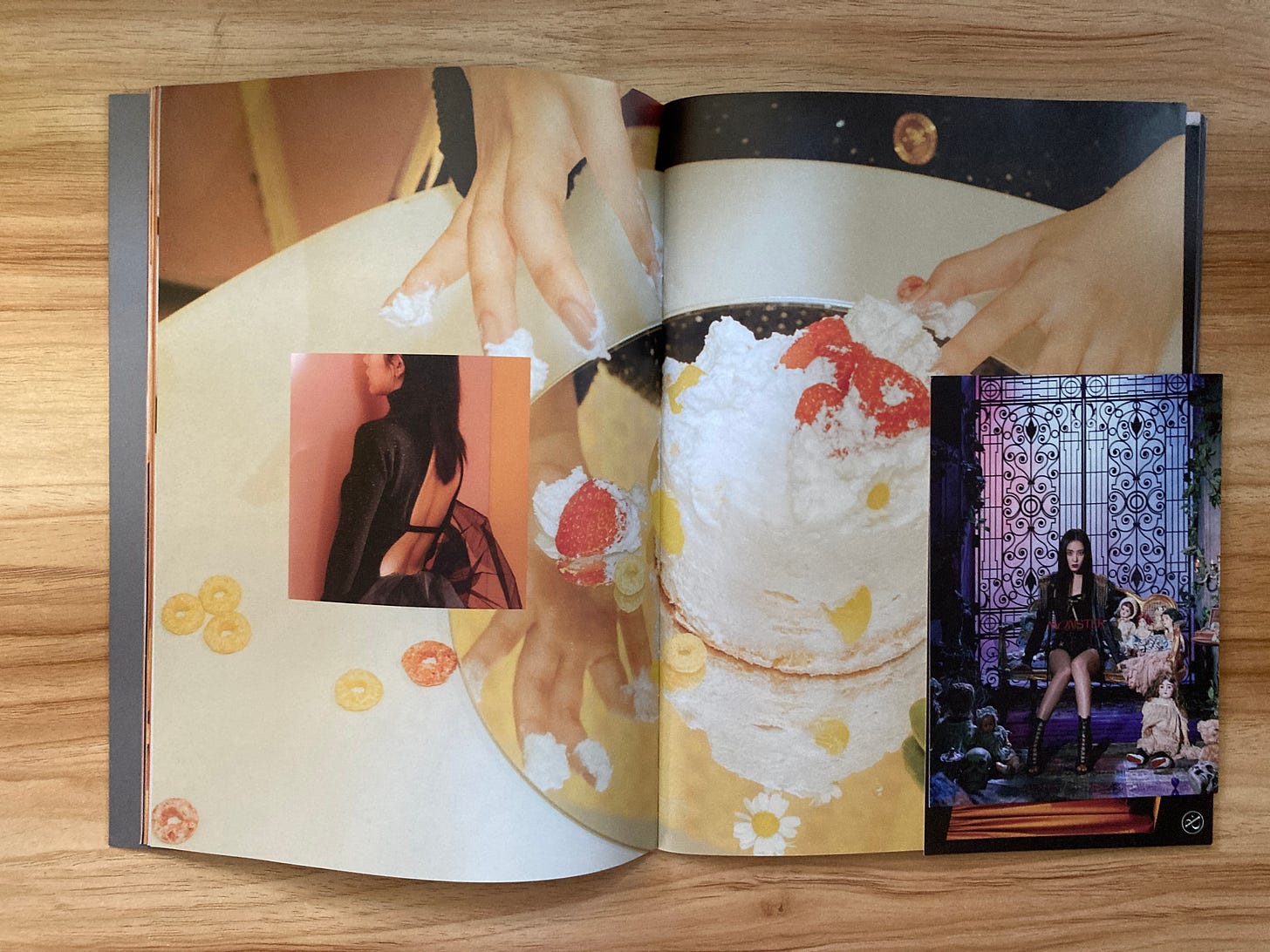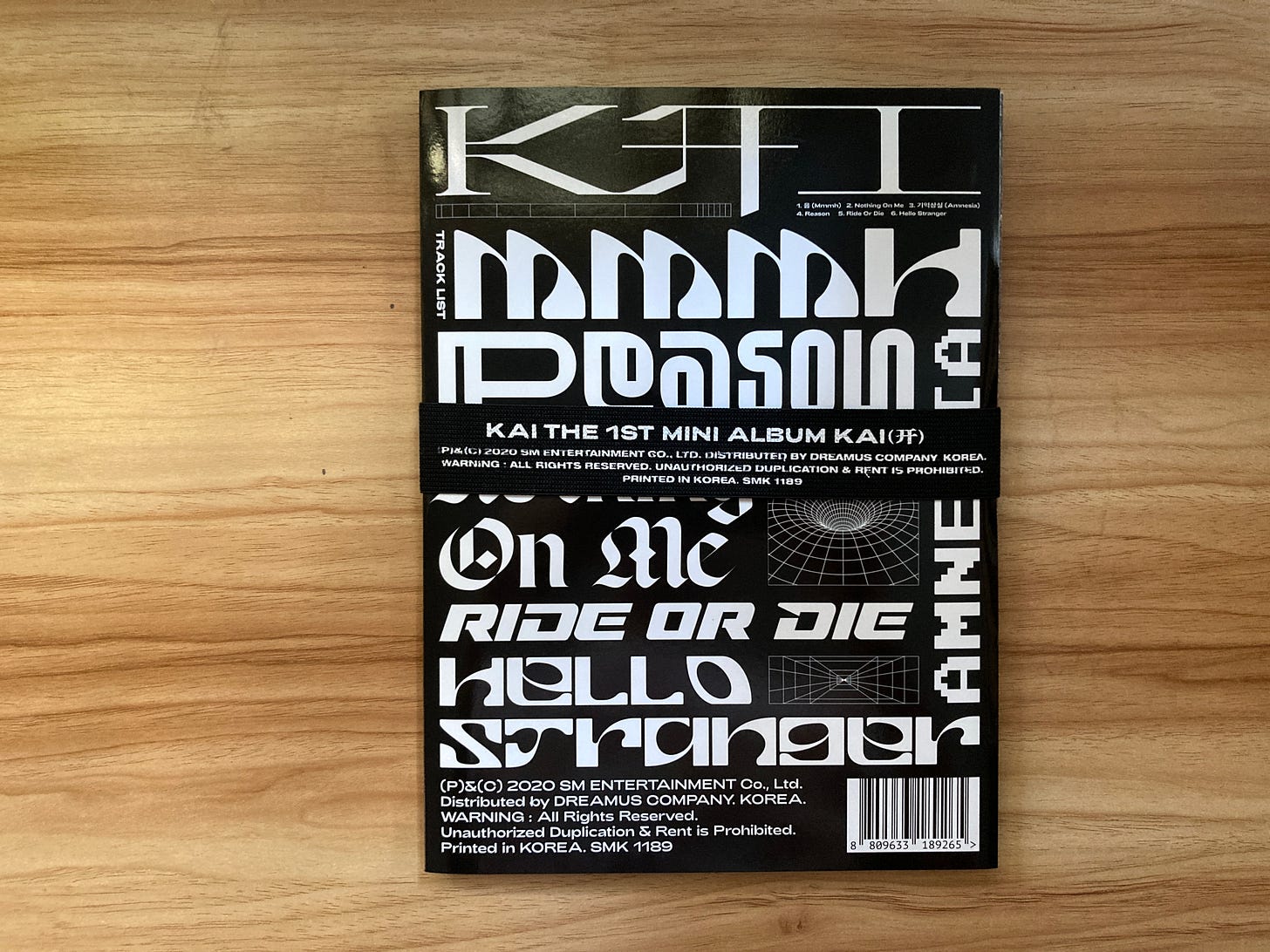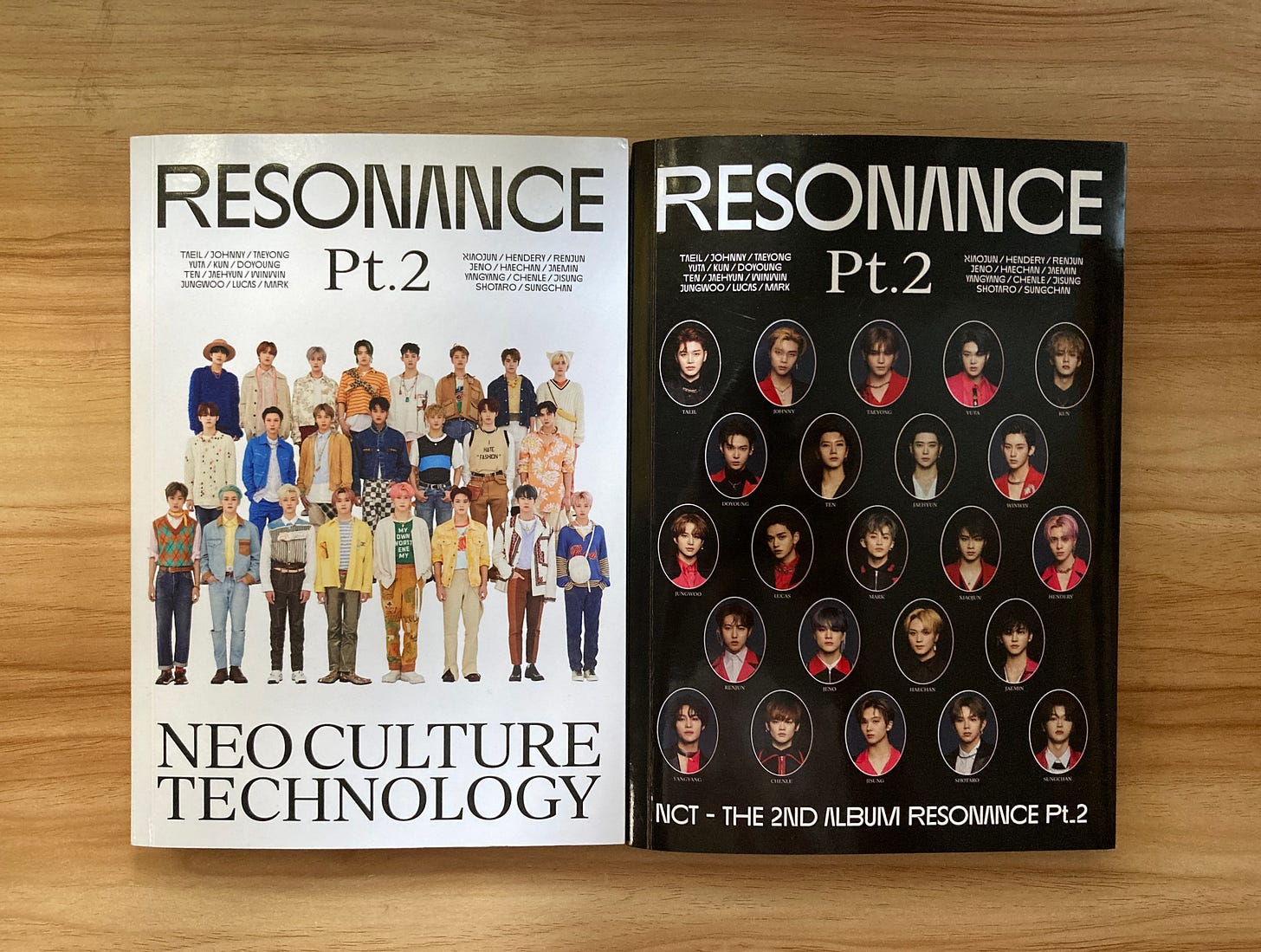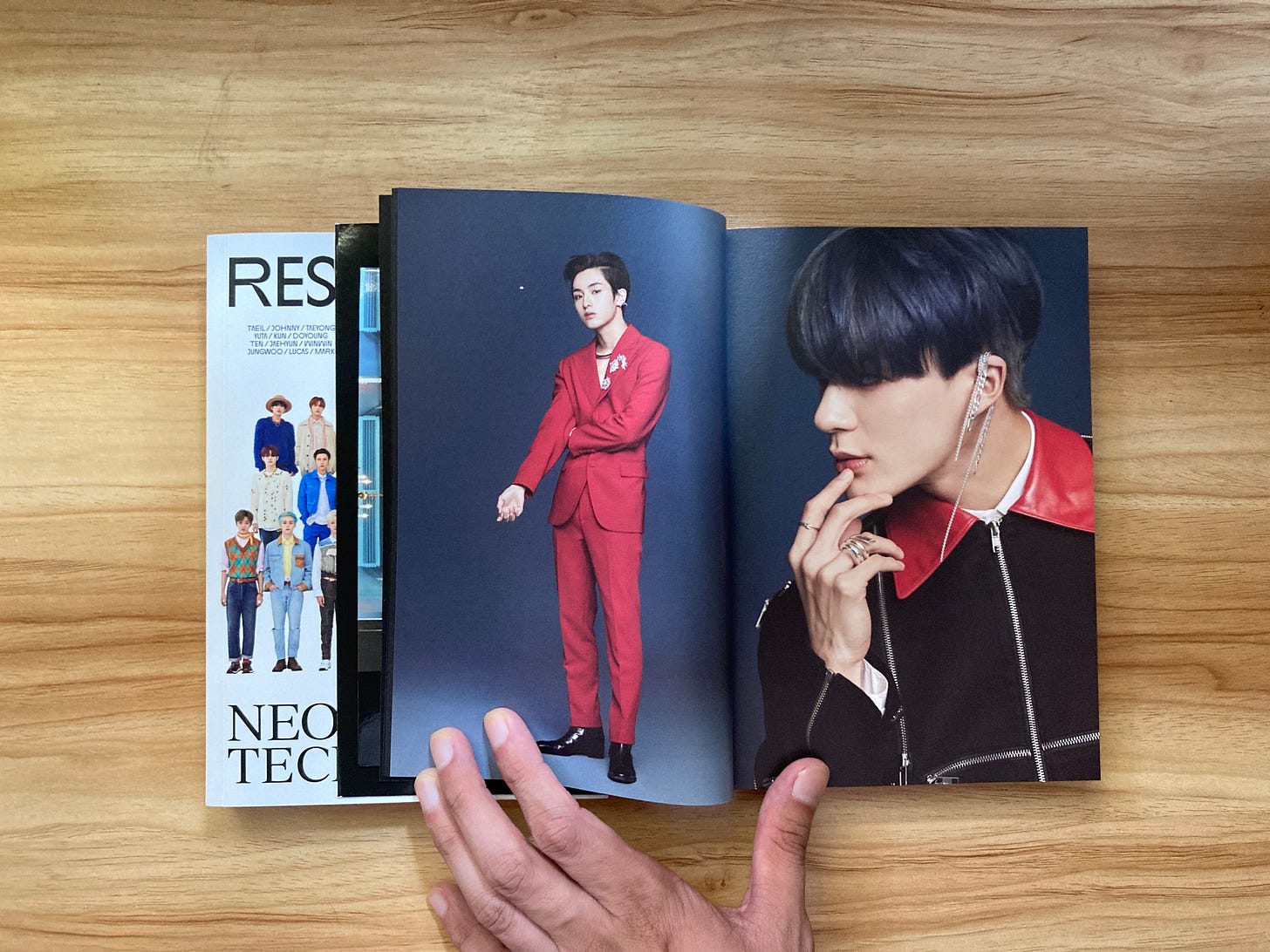I did not expect this deep dive into buying physical K-pop albums. It’s fairly known that many of us turned to hobbies and collectibles as coping mechanism when all the world is going up in flames. But honestly, this new phase of my lockdown distraction — I mean hobby — has been keeping me from imploding due to the government’s awful and inhumane response to the COVID-19 crisis. My first phase was impulsive book buying, which led to more unread books in my tsundoku. Then there’s the fantasy book phase, which was emboldened by the fact that I finished Jonathan Strange and Norrell in three weeks. Then came the K-pop albums.
I actually asked a friend to sell me her extra copy of Kai’s Mmmh last December — a time before this hellish fire engulfed me. First, it was the graphic design that convinced me, second was the fact that Mmmh is one of the best albums I’ve listened to last year (give it a go if you haven’t or let this convince you), and third was, well, imagine pages and pages of Kai.
I’ve forgotten about it until I bought all four of NCT 2020’s Resonance (purchased without photocards because that would amount to something like ₱6,000). I bought the albums because their book-like make appealed to me and, as I was in my “Baby Don’t Stop” phase, I made it a mission to get to know all 23 of NCT and the photobook is a very nice physical aid to help me with that (there’s a whole story about my NCT blackhole but let’s not get into that).
Here are the two versions (Departure and Arrival) of Resonance Part 2. It’s standard for K-pop albums to have several versions, perhaps to entice fans to purchase more copies as more versions mean more photocards to collect — something that’s lethal for bank accounts of fans of big groups like NCT which as 23 members.
The Departure version is more of a cute concept where members are going camping but in idol style. Arrival is the more porma, stylish concept (literally arriving at the airport) which has a dominant red and white styling. The layout for both of the books is basically just pages and spreads of photos which is not bad considering the quality of the photos.
Since there are 23 members, each person gets one layout and it’s interspersed throughout their group “chapters.” The albums also come with a set of stickers (three to collect), a poster, and two photocards. Here’s an unboxing if you want to see what’s inside. I never understood the appeal of unboxing videos until I collected K-pop albums.
Naturally, I gravitated towards other NCT subunits, NCT 127, WayV, and NCT Dream. The two NCT 127 albums I got have the more appealing packaging and design. First is Neo Zone, which has a magazine-type layout and second is Regular-Irregular which has more of an art brochure type of photography.
I loved the photos for Regular-Irregular and, understandably, it drew some flak for its irreverent treatment (most of the member photos are blurred). My only complaint is that it should have had more pages and printed on higher quality paper. French-Carribbean photographer Laurent Segretier took the whole Seoul-based 127 group concept (127 is Seoul’s longitudinal coordinate) and created a dreamy cityscape where the idea of idols feel like a fleeting fantasy.
For the digital booklet, they also released a more straightforward shoot based on the Regular-Irregular layouts.
SM has been releasing album versions in a magazine-type photobook format lately and it’s really a great way to showcase the high quality photos and design. Here’s the Red Velvet Irene-Seulgi subunit release Monster. As far as I know, SM Entertainment has an in-house design team, which explains the similarities of the packaging. That’s not bad in a way that it gives their releases a “trademark” that is noticeable for multi-stans.


It’s amazing how the capitalist K-pop machinery has managed to maintain both the physicality and digital aspect of music merchandising. At a time when streaming is the last hope for many artists and concerts have stopped due to the coronavirus pandemic, K-pop still manages to survive and give fans something to look forward to almost every day. It’s taxing at times, realizing how much fans should have to shell out to “support” the groups that they love but it’s not a big deal for those who can actually spend — or save — just to express their love for their respective groups. My brief foray into K-pop buy-and-sell Twitter yields interesting stories. Many of the fans are still in school so they find ways to buy merch, which can go for upwards of ₱1,000 apiece. Some go on quitting sales (a fire sale of all previous merch) just so they can have funds for the group’s next comeback.
The physical design of albums is an important part of K-pop. “An album is regarded as a present or a service from an entertainer to their fans,” says Bohuy Kim in an interview with AIGA Eye on Design. Kim is the founder of Seoul-based studio Odd Hyphen and which has designed K-pop albums for WayV (Awaken the World) and NCT 127’s Seasons Greetings 2021 (another annual cash cow for idol groups).
Band merch isn’t a new thing nor it is exclusive to idol groups (even Oreo Cookies aren’t safe). As much as $3.1 billion account for global sales in 2015-2016. But K-pop has managed to form an organized system that both satisfies the fans and the need to consistently turn out content for groups. It takes as much as 2 billion KRW to debut a group — what more sustaining their relevance? You also have to factor in the years of training and emotional investment that each member has to undergo.
It took a spreadsheet of my own K-pop expenses to make me stop and think how much capitalism governs so much of our lives, even the most innocent seeming corners. I turned to K-pop for happiness (majority of my laughter these days are because of K-pop reality shows) but my venture into merch buying — and the intensity of it — scares me. K-pop merch Twitter gets a lot of flak, every week or so, for pouring in thousands of pesos into photocards. Unless they’re stealing or scamming people, you shouldn’t tell them how to spend their money for their happiness — what little of it we can get in these dark times.













